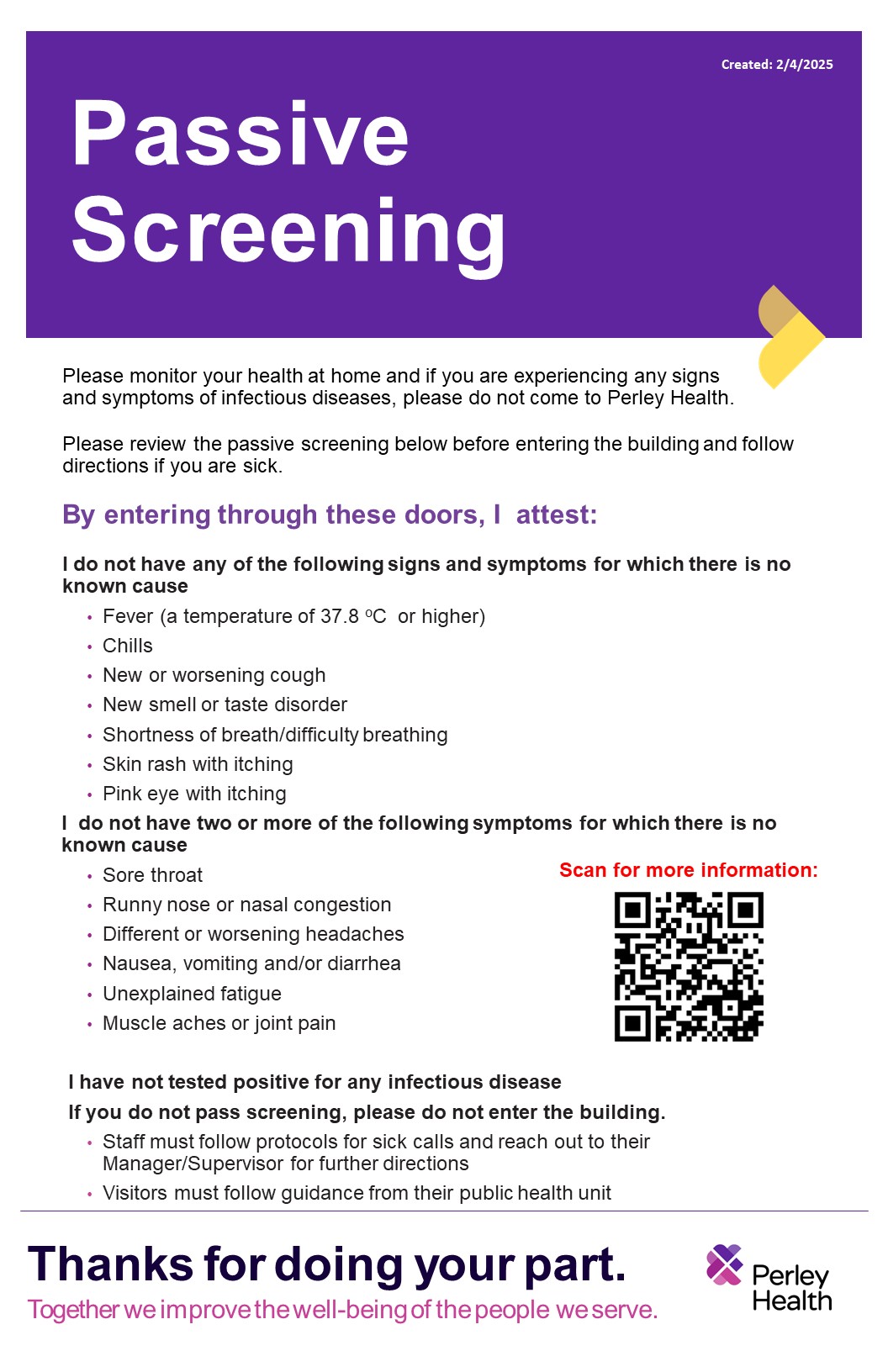Visiting
Reference Documents
- View Visitor Policy (.PDF)
- Supporting Documents (.PDF)
- Signs and Symptoms of Infectious Diseases (See below)
- Screening is to be completed at home or before visiting
- Pet and Animal Policy (.PDF)
- Appendix of Pet Policy (to be signed)
- Fixing Long-Term Care Act, 2021 (FLTCA) (.PDF)
- Download the "Passive Screening" poster (.PPTX)
- Caregiver Designation Form (.PDF)
- FOB Application Form (.PDF)

Signs and Symptoms of Infectious Diseases
Infectious diseases are caused by microorganisms, such as bacteria, viruses, parasites or fungi. These diseases can spread from the environment or from one person to another resulting in illness.
Signs and symptoms vary depending on the organism causing the infection. Infections can be classified in a number of different ways. They may be localized (affecting a specific part of the body) or systemic (affecting the body as a whole). Some are generalized and nonspecific, like fever and fatigue while others are specific to the body part, such as a rash or swelling of a joint.
The body's first line of response to any infection may be characterized by some generalized signs and symptoms as follows:
- Fever
- Chills
- Headache
- Fatigue
- Malaise
- Muscle aches
- Joint aches
- Swollen lymph nodes
Examples of Infectious Diseases include:
Enteric Diseases and Food-Borne Diseases: These diseases are caused by micro-organisms such as viruses, bacteria and parasites that cause intestinal illness. They most frequently result from consuming contaminated food or water and some can spread from person to person.
Symptoms of a gastrointestinal tract infection may include:
- Abdominal pain
- Diarrhea
- Nausea and vomiting
- Fever
Respiratory Disease: These diseases are caused by organisms such as viruses or bacteria that affect the respiratory system (e.g., lungs and throat). The organisms can be spread by coughing, sneezing or face-to-face contact.
Symptoms may include:
- Sneezing
- Runny nose
- Nasal congestion/discharge
- Scratchy or sore throat
- Coughing
- Shortness of breath
- Fever
Eye infections: These infections are common because the eye is vulnerable to pathogens that are easily transmitted by hand-to-eye contact or an eye injury. An eye infection often involves only one eye but can easily spread to both.
Symptoms may include:
- Deep pink color in the white of the eye
- Eye swelling, itchiness, or burning
- Excessive tearing
- Eye discharge
Blood Borne Infections (BBI): These viruses are carried in the blood, and can be transmitted through sexual contact, sharing needles, needle-stick injuries, from mother to baby during pregnancy, during birth or through breastfeeding. BBIs may also exist in other body fluids.
Sexually Transmitted Infections (STIs): STIs are caused by microorganisms such as viruses or bacteria that are transmitted through sexual contact.
Vaccine-Preventable Diseases (VPD): Some diseases are caused by viruses and bacteria, and can be prevented by vaccines.
Examples of VPDs include:
- Chicken Pox / Shingles
- Measles
- Hepatitis A/B
- Influenza
- Tetanus
Vector-Borne and Zoonotic Diseases: Vector-borne and zoonotic diseases are caused by viruses, bacteria or parasites that are transmitted to humans from animals or insects.
Surveillance
Surveillance data for infections is collected and recorded for residents according to best practice in Long Term Care and for staff based upon the Ontario Medical Association/Ontario Health association (OMA/OHA) Communicable Disease Surveillance Protocols for Ontario Hospitals.
Data is reviewed by the IPAC team for any epidemiological link to help identify clusters and further enhance/implement infection prevention and control measures to assist in preventing and controlling infections to those within the home.